« November 2008 | Main | January 2009 »
December 30, 2008
The World in His Arms

Raoul Walsh - 1952
Universal Region 1 DVD
Does anyone else think that Raoul Walsh's film age better than those of Howard Hawks or John Ford? It may be revealing that while Hawks and Ford's films in the Fifties became longer, with increasing tendency to make grand statements, Walsh continued to make films pretty much as he always had, which was to have fun and shoot a movie on the side. Except for the fact that his career was based on the invention of the motion picture camera, I'm not sure if Walsh really had much use for the 20th Century. Even the contemporary films often were about characters nostalgic for the past, or acting on outmoded codes of honor. The acting was rooted in the 19th Century stage, transposed to film first by Walsh's mentor, D.W. Griffith. Walsh may have seemed out of his time, especially during the last decade of his career, yet it is that same remove, more than fifty years later, that keeps his films from seeming as dated as a misfire like Hawks' Red Line 7000.
Viewed at a time of animal rights and protection of endangered species, some audience members may be appalled by the attitude towards seals and the seal pelt trade in The World in His Arms. The difference between Gregory Peck, and the Russians who run the fur trade in this 1850 tale, is that Peck is enlightened enough to take "what is needed", while the Russians seem bent on getting every seal to the brink of extinction. What ecological message there is takes a back seat along with the faint Cold War allegory which essentially states that that the Russians are O.K. but for their undemocratic government and the people in charge.

This may not be among the best of Raoul Walsh's films, but it has almost everything one would want. It's only about two minutes into the film when the first of several fist fights breaks out. Gregory Peck is a sea captain so successful at poaching furs from the Russians that he is able to raise ten million dollars to buy Alaska for himself. His chief competition, aside from the Russians, is Anthony Quinn, a rival captain who will shake hands and steal your watch at the same time. Peck falls in love with chipmunk faced Ann Blyth, a Russian countess who is to marry the much older nephew of the Czar.
The story is less important than watching Quinn try to steal Peck's boat, Blyth, crew and the movie, at one point having an arm wrestling match on a ballroom floor. Being a Walsh film that initially takes place in San Francisco, Peck knows all the "dance hall" girls who show up at the ritzy hotel much to the dismay of fussy proprietor Hans Conried. The one bit of authentic casting involves Eugenie Leontovich as Blyth's aunt among such faux Russians as Carl Esmond and Sig Ruman. There's also a pet seal, first seen in one of the hotel bathtubs. There's even young Bryan Forbes in his first Hollywood role.
One might quibble with what may be a proto-Dixieland jazz band that makes an appearance to liven up a formal dance at the hotel. More difficult to watch is the footage of seals on the Alaskan coast, blown up from 16mm, even more obvious when used as rear projection while Peck is leading his hunting expedition. The boat race between Peck and Quinn looks real enough, though. This may be the only Walsh film where one might gush about the costumes, taking full advantage of beautifully preserved technicolor. And while Peck may not measure up to more frequent Walsh heroes like Flynn and Gable, there is a thrill in watching him burst through a church window to keep Ann Blyth from marrying Carl Esmond. It is fitting for this most classic of action directors that a recurring line from one of the characters is, "We go".

Posted by Peter Nellhaus at 12:18 AM
December 28, 2008
Coffee Break

Michel Boujenah and Roland Giraud in Three Men and a Cradle (Coline Serreau - 1985)
Posted by Peter Nellhaus at 12:02 AM
December 27, 2008
My responses to "PROFESSOR KINGSFIELD'S HAIR-RAISING, BAR-RAISING HOLIDAY MOVIE QUIZ"
While one could read my responses to the latest quiz at Sergio Leone & the Infield Fly Rule, they may be easier to read here. For those not familiar, Dennis Cozzalio has a fictional professor presenting a list of questions ranging from academic to the outright silly, all related to film. Answering the questions is sometimes a time consuming ordeal. The best part is reading other peoples' answers to see if anyone has actually checked IMDb - for example the person in a previous test who confused Fritz Lang with Friz Freleng. Sometimes the questions need to be examined a little closer. One of the questions this term involves the choice between two Fox foxes, Sheree North and Jean Peters. Had I made it in academia, I would have posed a smackdown between Fay Spain and Yvette Vickers, or maybe Setsuko Hara and Hideko Takamine.
1) What was the last movie you saw theatrically? On DVD or Blu-ray?
Last film theatrically: Pere Noel est une Ordure. On DVD: Fasssbinder's Third Generation, with Burn After Reading coming next.
2) Holiday movies— Do you like them naughty or nice?

Crooks Anonymous (Ken Annakin - 1962)
Naughty is nice.
3) Ida Lupino or Mercedes McCambridge?
Is that a fair question? Lupino as an actress and as a director.
4) Favorite actor/character from Twin Peaks
Joan Chen, though I'd show up where Peggy Lipton is serving coffee.
5) It’s been said that, rather than remaking beloved, respected films, Hollywood should concentrate more on righting the wrongs of the past and tinker more with films that didn’t work so well the first time. Pretending for a moment that movies are made in an economic vacuum, name a good candidate for a remake based on this criterion.
I'd actually like to see Dr. No filmed as Fleming wrote it, with Bond battling a giant octopus.
6) Favorite Spike Lee joint.
So hard to choose. Probably Inside Man for being the most entertaining.
7) Lawrence Tierney or Scott Brady?
Tierney did more memorable work.
8) Are most movies too long?
Yes.
9) Favorite performance by an actor portraying a real-life politician.
Harvey Keitel as Tom Paine in La Nuit de Varennes.
10) Create the main event card for the ultimate giant movie monster smackdown.
Gorgo vs. Godzilla
11) Jean Peters or Sheree North?

Ms. North was a cutie, but Jean Peters has Anne of the Indies, Viva Zapata! and Pickup on South Street on her resume.
12) Why would you ever want or need to see a movie more than once?
Some films get better with multiple viewings. And sometimes one gives in to participating in a blog-a-thon.
13) Favorite road movie.
Alice in the Cities
14) Favorite Budd Boetticher picture.
Of available films on DVD, Ride Lonesome because of Pernell Roberts and James Coburn and the physical presence of Karen Steele. I do wish The Rise and Fall of Legs Diamond was on DVD, though. I saw it a couple of times on TV. Boetticher and cinematographer Lucian Ballard pissed off Jack Warner by shooting in the style of a Thirties gangster movie.
15) Who is the one person, living or dead, famous or unknown, who most informed or encouraged your appreciation of movies?
Encouragement: Mom. Informed: initially Andrew Sarris.
16) Favorite opening credit sequence. (Please include YouTube link if possible.)
I think everyone's seen the Walk on the Wild Side credit sequence enough to have it almost memorized.
17) Kenneth Tobey or John Agar?
I'm giving this to Agar. Not only was he in more actual movies, but he played the one and only Billy Shear in Along the Great Divide, thereby allowing me to sneak in a pop song reference that Dennis might appreciate.
18) Jean-Luc Godard once suggested that the more popular the movie, the less likely it was that it was a good movie. Is he right or just cranky? Cite the best evidence one way or the other.
More often than not, Godard seems to be cranky. Contempt is probably his most popular film and is often considered his best.
19) Favorite Jonathan Demme movie.
Married to the Mob
20) Tatum O’Neal or Linda Blair?
I should probably answer with Jodie Foster. My twelve year old niece really likes The Bad News Bears as do I, so the vote goes to Tatum.
21) Favorite use of irony in a movie. (This could be an idea, moment, scene, or an entire film.)
The moment in Medium Cool when the off screen voice yells to Haskell Wexler that what they are filming is real.
22) Favorite Claude Chabrol film.
Les Bonnes Femmes
23) The best movie of the year to which very little attention seems to have been paid.
Minoru Kawasaki gets introduced to the US on three DVDs. The Rug Cop is the funniest.
24) Dennis Christopher or Robby Benson?
Christopher for Breaking Away, Don''t Cry, It's only Thunder and his part in the TV series "Profiler".
25) Favorite movie about journalism.
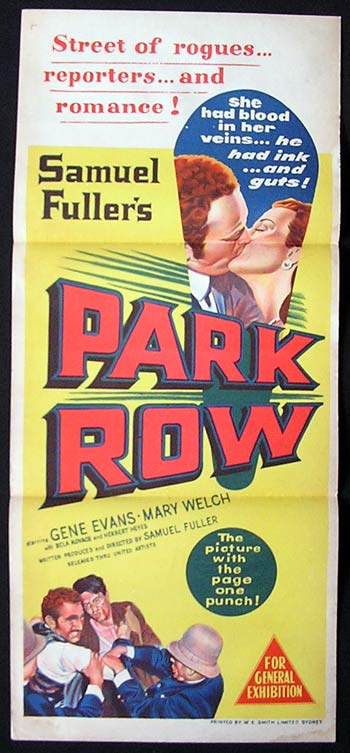
Park Row
26) What’s the DVD commentary you’d most like to hear? Who would be on the audio track?
Sam Fuller would have made commentary tracks that would have been as good or better than his movies.
27) Favorite movie directed by Clint Eastwood.
Bird.
28) Paul Dooley or Kurtwood Smith?
Dooley, mostly for his support in Altman films.
29) Your clairvoyant moment: Make a prediction about the Oscar season.
I will have seen even fewer nominees than in previous years and won't even care.
30) Your hope for the movies in 2009.
My hope is that there some good new movies to be seen.
31) What’s your top 10 of 2008? (If you have a blog and have your list posted, please feel free to leave a link to the post.)
I don't have a top ten. But The Class is my choice for the best of 2008.
BONUS QUESTION (to be answered after December 25):
32) What was your favorite movie-related Christmas gift that you received this year?
I'm a Buddhist. I'm not even expecting any movie related Hanukkah gifts for that matter.
Posted by Peter Nellhaus at 12:46 AM
December 25, 2008
The Hanna Schygulla 65th Birthday Celebration

I didn't realize until after I read the credits that it was Hanna Schygulla that I saw in Edge of Heaven. She plays the mother of a young woman, a college student who becomes involved in the life of a Turkish political refugee. At a certain point, the mother, who seems like any conservative older woman, tells the daughter that she had her radical side when she was younger. One can view this scene simply on its surface level of a mother confiding her hidden past to her daughter. As the part is played by Schygulla, one can also interpret the scene as referring to her actual life, or as the characters she played in her earlier films, especially those made with Rainer Werner Fassbinder. It is for those overlapping reasons that Fatih Akin cast Schygulla in that role.
A more appropriate tribute would involve re-seeing the films that Schygulla starred in, especially Effie Briest, and The Marriage of Maria Braun, plus Volker Schlondorff's Circle of Deceit. Without knowing the extent of her involvement, I saw one of her earlier performances for Fassbinder, plus the film she did right after Maria Braun cemented her position as the actress most closely associated with Fassbinder.

Schygulla is seen only in the beginning of Herr R. as a friend of Frau R.'s. With her identifiable curly hair, Schygulla is the free spirit whose existence represents a break from the regimented lives of the R.s. One of the points of discussion is Schygulla's nest of curly hair, as if the straight hair of Kurt Raab and Lilith Ungerer stood as a visual signifier of their lives. It was that mop of hair, barely controlled coils, that made Schygulla recognizable. One almost wished that the film she was in had followed her instead of the repressed, conforming couple of the title.
The Third Generation is more of an ensemble piece initially deemed a failure coming soon after the international success of Maria Braun. Schygulla's role links the other characters. She is introduced as the secretary to businessman Eddie Constantine, and daughter-in-law to a police agent. The agent's son, played by Udo Kier, along with Schygulla, are part of a group of youngish adults who live comfortable, middle class lives, but are part of a "terrorist" cell. The police agent is seen dressed similarly to someone in a classic Fritz Lang film, with trenchcoat and oversized fedora. The Third Generation has generated more interest in part of his line, "I recently had a dream that capitalism invented terrorism to force the state to protect it." Schygulla's hair is shorter, and straight. She was never quite conventionally attractive, yet there is no questioning that men would find her attractive as when Constantine talks about her with Hark Bohm.

Life and art seem to have intermingled as Schygulla's life has not been too different from the character she played in Herr R.. Except for a very brief turn in Hollywood, Schygulla has managed to work steadily in films that were more artistic than commercial in motivation. I'm probably not the only one who might now be re-thinking that list of twenty favorite actresses. And while there are those who will argue the value of certain films made by Fassbinder, I will be the first to admit that I'd rather see those films with his most frequent onscreen collaborator.
Posted by Peter Nellhaus at 10:40 AM | Comments (2)
December 23, 2008
The Wedding Director

Il Regista di Matrimoni
Marco Bellochio - 2006
New Yorker Film Region 1 DVD
On a superficial level, one can liken The Wedding Director to Eight and a Half. Marco Bellochio's film is about the misadventures of a movie director, his troubled relationships with women, and his uncertain attempts in setting up his newest project. A relatively lighthearted break between the serious Good Morning, Night and a new film about Mussolini, Bellochio looks at the filmmaker as celebrity. The basic story is about a relatively well known director, visiting Sicily, who is blackmailed by the still influential, if impoverished, local prince, into filming the wedding of his daughter. Complications arise when the director, Franco, and the prince's daughter, Bona, fall in love.

What is more interesting about The Wedding Director is not the story, but the events that take place incidental to the narrative. Early in the film, a television report is aired that a famous film director has died in a car accident. The tragedy spurs others in Italy's film industry to vote for the director to get a "David", the Italian equivalent to the Oscar. There is the comment that the dead rule in Italy, yet it takes very little to see that the history of art, not only film, is full of posthumous recognition of its practitioners. When Franco is discovered on the beach by a local filmmaker shooting a wedding video, Franco is pressed to share his ideas on how to make the video more interesting. While we hear the suggestions on the soundtrack, we see the imagined film - madcap running back and forth across the beach, the young couple making love with the bride undressed, the couple then leaving the beach to the dismay of the rest of the family - a combination of comedy and eroticism that the local filmmaker rejects. Franco is reputed to be preparing a new film based on the novel The Betrothed. Brief excerpts of what appear to be one of the earlier filmed versions of the novel are intercut into the action while Franco and Bona compare themselves to Manoni's characters.
Bellochio makes constant use of framing devices. Characters are frequently seen behind windows or glass doors. There are repetitions of rectangular patterns, on walls, floors and ceilings. Bellochio includes shot of people looking at viewfinders and video monitors. Ideas about love and life are received second hand from popular culture. The prince, manipulating people to consolidate his remaining power, like the title character he refers to, asks Franco to film the wedding like Visconti's The Leopard. "Temptation" and "Autumn Leaves" are among the songs on the soundtrack. In The Wedding Director, the chaos of life keeps interfering with lives imagined as movies.

Posted by Peter Nellhaus at 12:55 AM
December 22, 2008
Robert Mulligan: 1925 - 2008

Some men climb the mountains
Some men swim the seas
Some men fly above the sky
They are what they must be.

I do not love for silver
I do not love for gold
My heart is mine to give away
It never will be sold.

Baby the rain must fall
Baby the wind must blow
Wherever my heart leads me
Baby I must go
Baby I must go.
"Baby, the Rain Must Fall" - lyrics by Glenn Yarbrough
Posted by Peter Nellhaus at 12:08 AM | Comments (1)
December 21, 2008
Coffee Break

Humphrey Bogart in Bullets or Ballots (William Keighley - 1936)
Posted by Peter Nellhaus at 12:05 AM
December 19, 2008
A Christmas Tale (2005)

Cuento de Navidad
Paco Plaza - 2005
Lionsgate Region 1 DVD
Taking place in 1985, Paco Plaza's film takes some of its cues from the films he watched as a twelve year old boy. The story of five friends, four boys and a girl, takes some of its inspiration from The Goonies and Explorers. One of the boys tries to model himself as the Catalan version of Ralph Macchio in The Karate Kid. Plaza's film, part of of a Spanish television horror series, goes in a much darker direction. There is some similarity to Victor Erice's Spirit of the Beehive regarding the myths created by movies and how children respond to that mythology. The behavior of the children also may remind some of Lord of the Flies.
The five children find a woman, dressed in a Santa Claus outfit, trapped in a pit in the woods. An attempt to rescue the woman ends when two of the boys, ignored by a policeman too busy discussing Christmas dinner with his wife, discover that the woman is wanted for robbery of two million pesatas (roughly ten thousand dollars). There is discussion about whether to still turn over the woman to the police for an unstated reward, or try to claim the stolen money for themselves. Only the girl, Moni, feeds the woman, Rebeca, when she can, with soda and packaged pastries. Two of the boys decide to turn Rebeca into a zombie on Christmas Eve, attempting to duplicate the instructions from a character from a favorite movie. When Rebeca is found lifeless a few days later, a policeman is brought to the scene where she was found, only the pit is empty of evidence that someone was there.

The real horror of Plaza film is the cruelty of the children towards Rebeca. Plaza contrasts the comfortable life of the children in their bedrooms during a rainy night, with Rebeca, hungry in the pit with a broken leg. When Rebeca seeks her revenge, it is almost a distaff version of Night of the Hunter, the tensioned heightened by the shadowed faces of the children, trapped in a disused amusement park. A brief shot of a Disney type castle in the background is a reminder of the connections between dreams, fairy tales and nightmares.
Hopefully, Plaza's most famous film to date, (Rec) will be available to judge his work better. If there is another incentive for seeing his Christmas Tale, it is for the participation of young Ivana Baquero. Best known for her performance as Ofelia in Pan's Labyrinth, Baquero will soon be making her English language debut opposite Kevin Costner in a film by Luis Berdejo, writer of Plaza's film. Plaza's Christmas Tale doesn't aspire to the visual or metaphorical heights of Erice or Del Toro, but on its own modest terms is an effective little thriller that reminds the audience that monsters are often other humans.

Posted by Peter Nellhaus at 12:41 AM
December 17, 2008
Pere Noel est une Ordure

Jean-Marie Poire - 1982
Universal Region 2 DVD
The title, if you haven't guessed, translates as "Father Christmas is a Shit". Unavailable in the U.S., Jean-Marie Poire's comedy is reportedly a cult favorite in France. I'm not sure if the film simply has not aged well, or if it just was not that funny to begin with. The frenetic pacing and forced outrageousness wear thin. Whatever Pere Noel may have offered in the way of black comic view of Christmas twenty-five years ago has aged badly. It is probably no surprise that unlike the more recent French holiday comedy, Daniele Thompson's La Buche, or the currently available Christmas Tale, Poire's humor fails because most of his characters are simply unlikable.
The film, which was remade as Mixed Nuts by Nora Ephron, takes place primarily at the office of a suicide hotline. The people running the hotline are at least as neurotic as the people they are attempting to serve. Mrs. Musquin keeps getting trapped in the elevator, unable to make it to the Christmas Eve dinner. Frigid Therese and prissy Pierre are attracted to each other but express their feelings awkwardly, she with a sweater he mistakes for a floor rag, he with an "erotic" painting of the gawky Therese imagined voluptuous and dancing with a pig. There is also the inept petty criminal Felix constantly brawling with his determinedly stupid wife, Zezette. A man from an unidentified Eastern European country tries to spread holiday cheer with a selection of inedible deserts. Only the lonely transvestite, Katia, garners any sympathy.

Could I be missing something here? Possibly. Poire is hugely successful in France. His one attempt in English, Just Visiting, a remake of the very popular Les Visiteurs, came and went in the Spring of 2001. Just the titles from Poire's filmography suggest a penchant for being deliberately provocative, such as Men prefer Fat Girls and My Wife Maurice. One of Poire's earlier screenplays, directed by Edouard Molinaro, Dracula and Son might be worthy of rediscovery if only for being the one film to star both Christopher Lee and Catherine Breillat. Poire certainly seems to have the loyalty of actors who appear in several of his films, and who have also shared in the crafting of the screenplays. Pere Noel may seem to some to serve as an antidote to the synthetic sweetness of too many holiday themed movies. In trying too hard to poke fun at that most desperate time of the year, Poire's film is both cynical and cheerless.
Posted by Peter Nellhaus at 12:56 AM | Comments (1)
December 16, 2008
Promises in the Dark
I was watching a DVD of a film I decided was really not worth writing about. Then I checked the extras. Among the previews was this subtitled trailer for Sars Wars, one of my favorite Thai movies. I've seen the film a few times, but never the trailer until now. As far as I'm concerned, this may be the best trailer ever, next to Orson Welles introducing something called Citizen Kane. Taweewat Wantha's film has killer zombies, a giant snake, Thai cinema's axiom - Somlek Sakdikul, and Lena Christensen as Dr. Diana. The trailer also features an honesty unmatched by most Hollywood films.
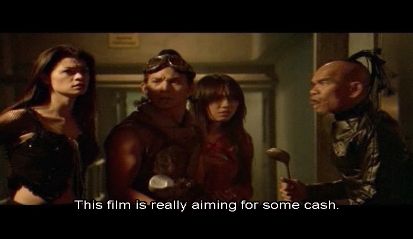



Posted by Peter Nellhaus at 12:26 AM
December 14, 2008
Coffee Break

Amy Brenneman in Off the Map (Campbell Scott - 2003)
Posted by Peter Nellhaus at 12:59 AM | Comments (3)
December 13, 2008
Delayed Happy Birthday, Rita Moreno

I was hoping to do a more timely celebration of the birthday of the hottest 77 year old woman on earth. Due to error of not getting the right DVD on time, I will write a few words on the one film starring Rita Moreno that I saw the night of her birthday. I should say that it's what remains of what was a passable juvenile delinquent story that the bone-headed producer recut, inserting soft core nonsense in an effort to repackage a film whose time had come and gone.
Released in 1960, This Rebel Breed might be best described as a mash up of West Side Story and High School Confidential. What's missing is the colorful extravaganza, songs, dance and artistry of the former, and the unabashed nuttiness of the latter. What is left is melange of vaguely articulated thoughts about race and prejudice in a Los Angeles high school. The casting of Natalie Wood as a Puerto Rican in West Side Story has nothing on This Rebel Breed's Mark Damon, with very dark make-up, as a half African-American, half Chicano undercover cop. Damon and his white partner pretend to be high school students to infiltrate a couple of gangs, the Royals with the white kids, the Ebonies, being the black gang.
Rita Moreno is Lola, the bright daughter of a Mexican metal sculptor and his deceased white wife. Secretly, Lola is dating one of the members of the Royals. Damon attempts to ingratiate himself on Moreno, meanwhile being rejected by both the Ebonies, and the Chicano gang. What interest This Rebel Breed has is not in the story or the message which may or may not have been intended inversions on parts of West Side Story. What remains are early performances by actors who who be seen in better films: Richard Rust, Al Freeman, Jr, Hari Rhodes, and a scene stealing Diane Cannon as she was then billed. Like the aforementioned cast member, Moreno is better than the material she has to work with, which she carries with dignity.
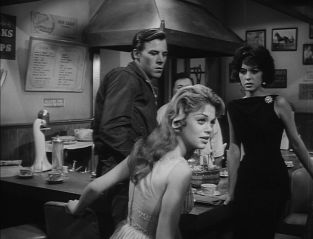
With an Oscar, a Tony, a Grammy and an Emmy, Rita Moreno should have been given more than supporting roles in films. Less accomplished performers have been given greater opportunities. Still, there are appearances in such films as The Ritz, I Like it Like That and The Lieutenant wore Skirts to savor.
Posted by Peter Nellhaus at 12:09 AM
December 11, 2008
Two by Frank Borzage - 1932

After Tomorrow

Young America
Frank Borzage - 1932
20th Century Fox Region 1 DVD
He calls her "funny face". She calls him "You big mug". Not everything that Frank Borzage filmed was a masterpiece, but this lesser work is still very entertaining, and revealing what kind of films could be made before the Production Code was enforced. It also marked the last time Borzage worked with Charles Farrell as his leading man. Instead of Janet Gaynor, the tiny brunette is Marian Nixon. The two play a couple whose extended engagement stretches to four years following financial difficulties and family problems. The New York City rear projection shots may be fake, but Borzage balances the romance and idealism with emotional reality.
Farrell's mother, ready to spout one homily after another, clings onto her son too closely. Nixon's mother has little interest in her daughter, and is planning to leave her husband for another man. Contemporary audiences may be intrigued to hear the young couple discuss abstinence with the absence of religious authority or "purity rings". This is a depression era tale where nobody has much money, and a date consists of gazing at the city from the top of the Empire State Building or sitting on a park bench during the evening.

After Tomorrow is lovingly photographed by James Wong Howe, especially the shots of Farrell and Nixon together. The title comes from a song the two sing, an expression of hope for a day that seemingly doesn't seem to come with each unexpected obstacle. Even if this film is not highlighted by Andrew Sarris, it still fits in with his description of Borzage's, "genuine concern with the wondrous inner life of lovers in the midst of adversity".
There are more stark reminders of poverty in Young America, a film about a delinquent boy. The boy, played by Tom Conlon, lives in what is little more than a shack, sharing the house with dirty children in torn clothing. His best friend, Nutty, played by young Raymond Borzage, lives in a modest cottage with his grandmother. Borzage's film falls uncomfortably between Wild Boys of the Road and Boy's Town. As a socially conscious message, Young America is not very convincing. Where Borzage succeeds is with the affection his two friends have for each other.
Top billed Spencer Tracy is on screen far less than his credit would suggest. He plays the drugstore owner married to married to do-gooder Doris Kenyon. The couple takes in Conlon much to Tracy's objections. Young America can be viewed somewhat ironically in light of what became one of Tracy's signature roles, with Kenyon in the proto-Father Flanagan role. Tracy would used more effectively by Borzage in Man's Castle. Here he serves mainly as a foil to Conlon and Kenyon. Young America is Borzage fulfilling his contract before going off to Paramount to made A Farewell to Arms. Even while the folksy solutions doled out by Judge Ralph Bellamy are unconvincing, Borzage makes the friendship between the two boys feel genuine.

Posted by Peter Nellhaus at 12:45 AM
December 09, 2008
20 Favorite Actresses
Just when I thought I was safe from memes and blog-a-thons, Nathaniel R. drags me back in. Here are a twenty actresses I will see in virtually anything they're in. Several are Thai actresses that aren't well known outside of Thailand, at least for now. Nathaniel wants me to tag five people so I hereby name The Self-Styled Siren (when she regains her health), Filmbrain, Flickhead, CineBeats, and CelineJulie to contribute if they are too busy saving the world, catching up with the Murnau-Borzage box, or something of greater value.

Maggie Chueng

Charlotte Gainsbourg

Anita Mui
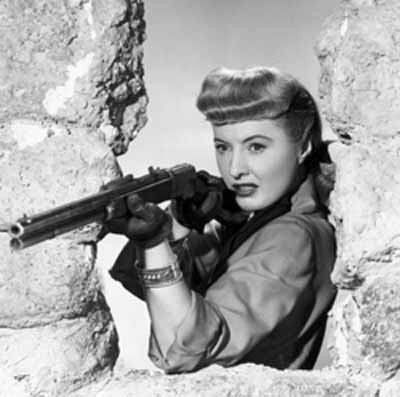
Miss Barbara Stanwyck

Bette

Natalie Wood
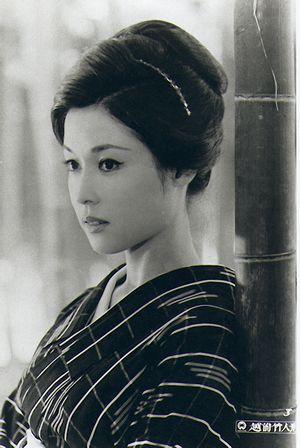
Ayako Wakao

Halle Berry

Ava Gardner

Brigitte Lin

Shu Qi

Julie Christie

Nong Toom

Lena Christensen

Tuesday Weld

Moon Sori
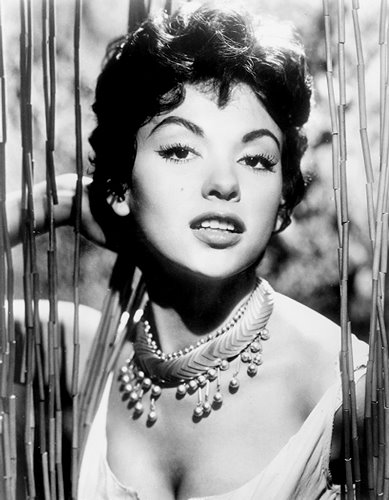
Rita Moreno
Marsha Wattanapanich

Romy Schneider
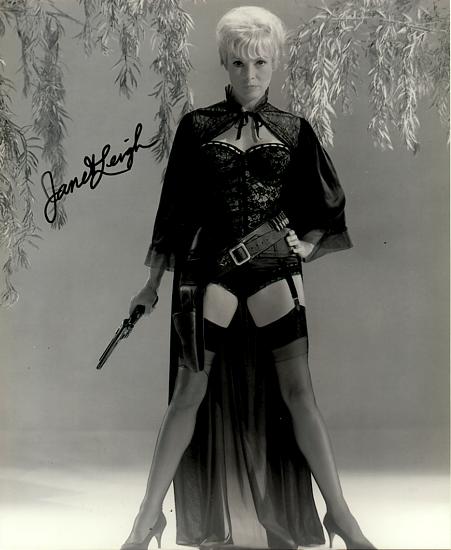
Janet Leigh
Posted by Peter Nellhaus at 12:45 AM | Comments (9)
December 07, 2008
Coffee Break

Rita Hayworth in Affair in Trinidad (Vincent Sherman - 1952)
Posted by Peter Nellhaus at 08:00 AM
December 06, 2008
Beverly Garland: 1926 - 2008

One of the high points of a free trip to Los Angeles to demonstrate my knowledge of film as staying at Beverly Garland's Holiday Inn. On the television was a documentary, constantly shown, that should have convinced anyone that Ms. Garland was the hardest working woman in show business. There were also the souvenirs available, notably an image of Garland with the monster from It Conquered the World. The place would have been even more perfect if movies with Beverly Garland were shown constantly, like at the Heartbreak Hotel in Graceland with the continual Elvis retrospective. Those of us from the Denver area who participated in that first season of "The Ultimate Film Fanatic" on the Independent Movie Channel dubbed ourselves "The Beverly Garland Film Society".
Conspicuous among the many television appearances and supporting roles in forgotten or forgettable movies is Garland's performance as Tuesday Weld's mother in Pretty Poison. Maybe had the film been more successful at the box office, Garland would have been nominated as Best Supporting Actress for 1968. Instead, the film stands out as an anomaly for an actress whose sense of professionalism seems to have been to take anything and everything that was offered, small parts in some big films, and larger parts in small films. One may argue about the quality of The Alligator People or Swamp Women, but not with the woman who stated, "We didn't do it tongue-in-cheek. We really meant it. We gave our all. We were serious, good actors and we played it seriously."
Posted by Peter Nellhaus at 11:50 PM | Comments (1)
December 03, 2008
White Dog

Samuel Fuller - 1982
Criterion Collection Region 1 DVD
I was not surprised when I first found out that Jon Davison was the producer of White Dog. During my first year at New York University, Davison briefly ran a semi-public cinematheque where I saw 16mm prints of Run of the Arrow, Hell and High Water and The Steel Helmet. Like Peter Bogdanovich before him, Davison attempted to revive Samuel Fuller's Hollywood career. Unlike The Big Red One which got a theatrical release following a severe edit, White Dog went straight to cable in the U.S. following rumors of racist content.
I might have seen Fuller's version of White Dog had the chief of Denver's short lived cinematheque not chickened out. Instead, Pick Up on South Street was presented. My souvenir from that evening is a signed copy of Fuller's novel 144 Picadilly. My other memory was the surprise in seeing how short Fuller was, barely breaking five feet, and his calling me "young boy", which I learned later was how he addressed a friend of mine who was also in his Thirties.

The only time I had previously seen White Dog was on cable, in a version that was not quite what Fuller had intended. Seeing it again, what struck me were certain visual motifs and use of color in the film. Before we see the white dog we see nothing, a black screen with the sound of a car in an accident. The first image is of Kristy McNichol. The sweater she is wearing prefigures the image of the dog with the use of an irregularly patterned red against white. There is also the allusion to other animals with McNichol's car, a Mustang, while her boyfriend drives a "Beetle" which is also the same color red as in the sweater. This same unsubtle shade of red is used in the berets worn by McNichol and Lynne Moody in the scene they are filming, a film within the film that is a recreation of the gondola scene in The Naked Kiss.
Even though the story originated with Romain Gary's novel, the relationship between McNichol's character, Julie Sawyer, and the dog, thematically is a continuation of Fuller's other films. Several of Fuller's films are characterized by the relationship between a male character who acts independently of society's rules and a woman, who may be an outsider herself, who attempts to "save" the man. Julie's attempts to keep the dog from being destroyed and to have it re-trained are in essence not dissimilar to the relationships of Richard Widmark and Jean Peters in Pick Up on South Street or Peter Breck and Constance Towers in Shock Corridor.
In the DVD supplement, Davison describes Samuel Fuller as loquacious. If there was ever a filmmaker who should have recorded a DVD commentary track, it would have to have been Fuller. It would have been nice to know how deliberate a visual joke it was to have a truck crash into a dress shop named Oscar's. The filmed scene that recalls The Naked Kiss is directed by Marshall Thompson, dressed like Fuller with the omnipresent cigar. In the supporting cast are past Fuller cast members Neyle Morrow, Richard Monohan and Parley Baer, as well as Fuller's wife, Christa Lang, and daughter, Samantha.
More significantly, Fuller reshaped Gary's novel so that the conclusion is almost a canine version of Shock Corridor. This comparison is two-fold both with Hari Rhodes' black Klansman - modeled after James Meredith and surprisingly prescient in light of Meredith's disavowal of the civil rights movement and his association with Jesse Helms - and Peter Breck's breakdown at the moment he discovers the truth about the murder of a former patient. The ending of the White Dog is consistent with many of Fuller's films, a pessimistic view of America that stubbornly is as valid in 2008 as it was when Fuller made his film, or when Romain Gary wrote his novel.

Posted by Peter Nellhaus at 12:00 AM | Comments (3)
December 01, 2008
Jan Dara
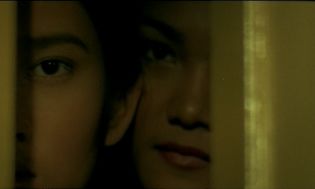
Nonzee Nimibutr - 2001
Dawoori Entertainment All Region DVD
Considering the various convulsions going on with the Thai film industry, it would seem that Nonzee Nimibutr might never make a film like Jan Dara again. Nonzee's third feature is not a genre exercise as are most Thai films. The depiction of sex would also be more likely censored as well. The best way to describeJan Dara is to think of it as a Thai version of a classic Greek tragedy, actually several combined into one. A more contemporary comparison might be with Tennessee Williams, without the coyness, a Freudian nightmare.
The story is about Jan, told with first person narration. His earliest memory is of seeing his father and aunt having sex. Throughout his boyhood, Jan is punished by his father for causing the death of his mother in childbirth. There is some solace to be found in relationships with women, but it is usually sexual. His relationship with his aunt, his mother's sister, takes on an Oedipal dimension. The one time Jan falls in love, with a young woman named Hyacinth, his relationship is so innocent that when the two walk together, he is holding onto the sleeve of her sweater rather than assert himself by touching her hand.
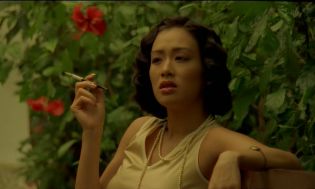
Jan takes the family name of his mother as his father constantly reminds him that he is unwanted. The father, Khun Luang. takes a mistress, Khun Boonlueang, referred to as Khun B. Along with the aunt, now married ot Khun Luang, Khun B also acts as a protector to Jan. Eventually, Khun B also becomes Jan's lover. The relationships within the family become more complicated, while the narrative descends more deeply into the theme of the sins of the father visiting the children.
Most of the film takes place from the late Twenties through World War II. The images are all awash in a golden hue, yet most of the memories could hardly be described as golden. Utsana Phleungtham's novel is reputed, at least by the author, to be based on true events that took place during the author's youth. For all of the sex, the most erotic scene in Jan Dara is of the teenage Jan (Suwinit Panjamawat) cooling Khun B (Christy Chung) with ice cubes melting on her back. Even though the film is about Jan Dara, Christy Chung takes over the film from her first appearance as the cigarette smoking, Westernized mistress loved by the two men of the house.
Nonzee seems to have lost some of his momentum since his debut in 1997 with Dang Bireley and the Young Gangsters, the film credited with kick starting Thailand's "New Wave". OK Baytong from 2003 is unavailable with English subtitles, and Nonzee's newest film, Queens of Langkasuka seems to have been hampered by a long running time, and too much similarity to a recent big budget trilogy about pirates. It should be noted that I bought the Korean DVD of Jan Dara which has the complete running time, compared to Kino's Region 1 version that is missing five minutes of footage. Central to this film, as well as his best known work, Nang Nak is the impossibility of love in the material world. Nonzee's characters strive for an ideal existence, but only those with absolute self-awareness find something close to happiness.

Posted by Peter Nellhaus at 12:13 AM | Comments (1)
